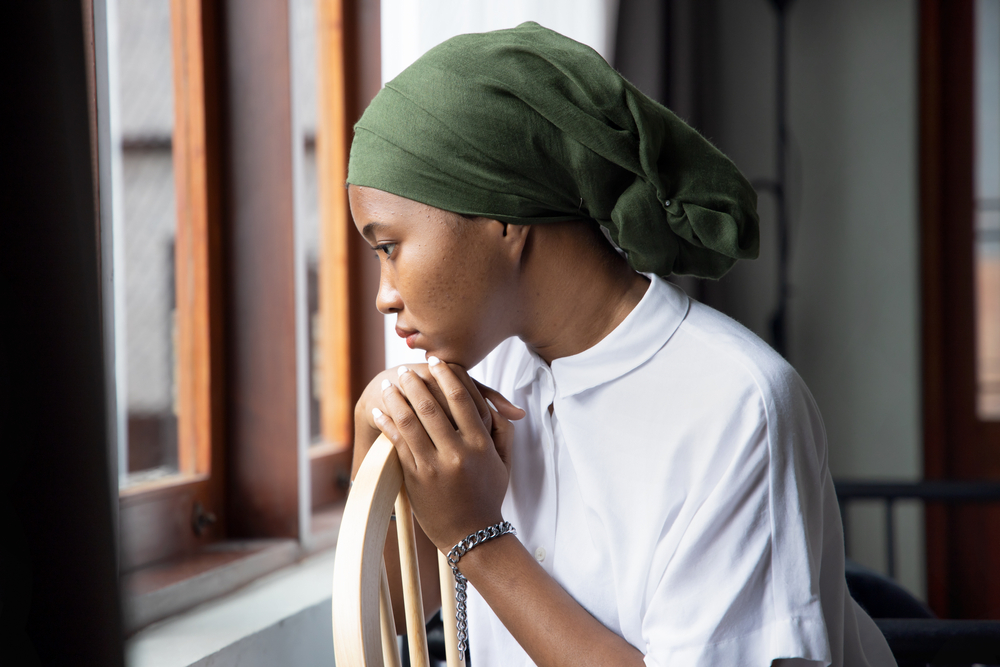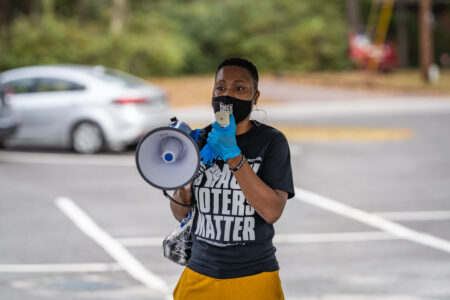About 12% of Black women will get breast cancer during their lifetime. At this time of year, every year, Breast Cancer Awareness Month is a momentous occasion to take action and drive awareness for more research, resources and support for one another.

When it comes to cancer and hair loss, chemotherapy is a take-no-prisoners hairstylist. With little warning or consultation, it can switch up our entire ethos, making us feel self-conscious — even a bit vulnerable. While a breast cancer diagnosis will raise more important factors about the future of our health, for some Black women, losing their hair while navigating one of life’s most critical events can have a direct effect on their well-being, too.
Chemotherapy-induced alopecia (CIA) is arguably one of the most shocking aspects for oncological patients, per the National Library of Medicine. A highly visible and tangible indicator that says someone’s life has changed, it often triggers overwhelming anger, depression, negative coping behaviors and worries of feeling exposed.
Although this temporary form of hair loss and its emotional toll are common for women of all races and ethnicities, these challenges create a more demanding cancer journey for Black women. For them, hair remains tightly connected to their identity, representing centuries-old principles and beliefs that understood racial category, gender designation, communal affiliation and class. It carries deep historical, political and social significance for Black people, yet it continues to be denigrated in work and academic spaces — dynamics typically underestimated by physicians which underscores a more pressing need for them to gain a greater understanding of CIA’s impact among their Black patients. In fact, a revealing study published by the American Cancer Society shows how some Black women, in attempts to avoid the emotional trauma often brought on by hair loss, have even declined cancer treatment altogether.
Janine Pettiford, MD, a surgical breast oncologist in Clayton County, GA, explains to WebMD, that when her patients learn they will need chemotherapy, typically their first question is about hair loss. A physician who is committed to upholding a respectful responsibility for how ethnicity ties into patient care for CIA, Pettiford first acknowledges and discusses how her patients feel before making sure they fully understand that CIA is not only common but temporary, and while everyone will respond to chemo in varied ways (in some cases the hair may only become thinner or not fall out at all), it is helping to control their disease so it doesn’t progress.
Dr. Pettiford also shares the following information with her patients and recommends its use as a general guide, offering more information about CIA. It’s a valuable jumping-off point for patients undergoing treatment or for those who are looking to offer support to a loved one but aren’t certain of what to expect.

Hair Loss as a Reaction to Chemotherapy
According to the American Cancer Society, hair loss typically happens fast because chemotherapy agents are designed to rapidly kill growing cells, such as those in a tumor. At the same time, hair follicles (they are highly active structures with their own host of cells) frequently divide in order to produce growing hair, but unfortunately, the hair strands are the innocent bystanders that often take the fall along with cancer cells.
Doctors advise if CIA is imminent for a patient, then they should expect hair loss to begin one to three weeks after the first chemotreatment. Patients may also notice the loss of eyebrows and eyelashes, but they usually don’t fall out until toward the very end of treatment protocols.
When a patient is experiencing hair loss, doctors also note the importance of considering all factors — stress or a vitamin D deficiency for example — they can also trigger a type of temporary hair shedding known as telogen effluvium as the body adjusts to chemotherapy treatment.
Preventing Hair Loss During Chemo
At any given time, hair loss is physically and emotionally affecting patients on a daily basis, so preventative care is crucial. One tool patients and their doctors can consider is a scalp-cooling treatment cap designed to reduce hair loss. To date, scalp cooling — the Paxman and DigniCap cooling cap systems specifically — is the only FDA-approved intervention for CIA prevention. Studies published in the Journal of the American Medical Association show that the treatment demonstrates positive success in between 50 to 80% of patients with early-stage breast cancer undergoing chemotherapy.
While the treatment shows big benefits and both manufacturers claim the systems are suitable for patients of all hair types, doctors do stipulate that scalp cooling is not 100% successful. However, they say that even if it doesn’t provide complete protection, the likelihood of experiencing persistent hair loss is less. In addition, although Black patients have seen progress with the treatment, there aren’t many studies about the efficacy of scalp cooling for varying natural curl types in most people of color.
Moreover, scalp cooling isn’t typically covered by insurance, but clinicians are advocating for it to be considered as a “restorative procedure” akin to breast reconstruction and hopefully, covered by most insurance providers in the future. So, with this in mind, oncologists recommend scalp cooling is worth a try.
How to Regrow Hair After Chemo
Usually, hair will start to regrow within two to three months after the final chemotherapy treatment, according to Dr. Pettiford, who adds that the texture may not be quite the same as before treatment began. It often resembles hair that may be finer in texture and less dense.
For some patients, treatments like minoxidil (which encourages blood flow) may help to speed up regrowth when applied topically or orally, as directed by a physician. And if your scalp develops a heightened sensitivity — it’s a common side effect — the use of mild cleansing and moisturizing products formulated without harsh irritants like alcohol, propylene glycol, sulfates and synthetic dyes will keep the hair and scalp nourished without any wear-and-tear while they grow and recover.

The Final Takeaway
Per the American Cancer Society, while Black women are less likely to be diagnosed with breast cancer than white women, Black women are 40% more likely to die from the disease. And for those who have undergone chemotherapy and other cancer treatments, hair loss is a common side effect, but nonetheless, extremely stressful. It may put individuals in spaces and situations they aren’t yet prepared to deal with.
Caring about losing your hair from chemo or not liking it when it first comes back is not narcissistic; it is normal and, actually, one of the most difficult parts of undergoing treatment.
After all, our hair is a big part of our identity, one that symbolizes great creative expression and freedom, so if you or someone you care about are experiencing moments of not quite recognizing the person in the mirror, please know you are not alone if you feel this way.
Black women face an array of disparities in cancer care, ranging from the lack of representation in clinical trials to below-par outcomes and higher mortality rates. While the following organizations can’t completely do away with these inequities, they play a crucial role in helping to navigate and overcome these barriers.








